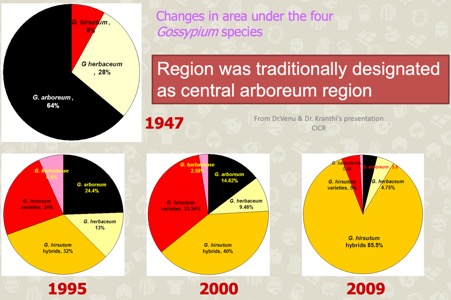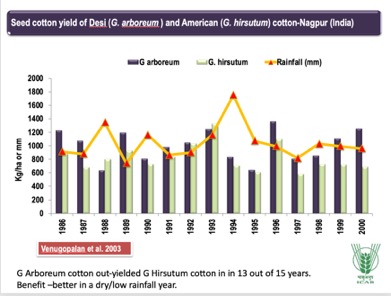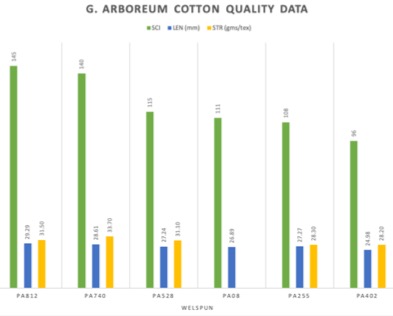Written specially for Vikalp Sangam
I have been fascinated by desi cotton for many years, and have been working towards its acceptance amongst farmers, farmer groups and the textile industry for some time. The revival of desi cotton could be a game changer for farmers in India and for sustainable cotton.
Gossypium Arboreum and Gossypium Herbaceum originated in India millions of years ago, and are commonly referred to as desi cotton species. Gossypium Arboreum is under commercial cultivation mainly in India and Pakistan. It was is in 1790 that the British introduced Gossypium Hirsutum (American cotton) from Malta and Mauritius, essentially to feed the textile mills in Lancashire and Manchester, and tried hard for nearly 150 years to replace the desi cotton but with little success.
In 1947 when India got independence the area under desi cotton was close to 97%. Although India produced the finest fabrics (Calico and Dhaka Muslin) which were woven from the coarse fibre of G Arboreum. However, soon after independence, the Indian cotton scientists declared the fibre of desi cotton as coarse, and focussed on improving only the American cotton, leaving the desi cotton on the verge of elimination.
Changes in species composition in India.

*Central Institute of Cotton Research Nagpur India
India has the largest cotton acreage in the world today (11 to 12 million ha), but cotton yields remain low and have been stagnant for the past 15 years at 511kgs/ha. India is essentially saturated by the double gene Bt-cotton and hybrid technology. These hybrids are expensive to cultivate, are highly input dependent and run the risk of collapse under biotic and abiotic stress. Let’s not forget that close to 70% of India’s cotton is grown under rain-fed conditions.
Desi cotton species survived the vagaries of nature for millions of years in India, and have the necessary resilience and robustness that are needed for long term sustainability (high yields at low production costs. They areideally suited for organic and sustainable production systems. and combat climate change. Some of its inherent strengths are:
- Deep rooted plants and the `Okra ‘type leaves allow for effective light penetration.
- Highly suitable for rain-fed conditions, for light marginal and saline soils.
- Species is endowed with high resistance levels to drought, salinity.
- Requires less fertilizers and chemical interventions due to high nutrient use efficiency and hence totally suited for organic and low input agricultural systems.
- High lint recovery at 38-40% gin out-turn compared to 32-34% in hybrid American species.
The yield and performance of Gossypium Arboreum vis a vis Gossypium Hirsutum can be gauged by the following research data of 15 years:

Weakness of G.arboreum (most of them have been overcome)
- Small boll size
- Propensity to shed seed cotton from open bolls necessitating more frequent picking
- Tall and lanky plants cause lodging if boll load is high.
- Poor fibre length
Seeing its potential, a handful of public sector breeders continued to work on them, by adopting non-conventional breeding approaches such as introgression. One such state agricultural university. The breeders from Vasantrao Naik Marathwada Krishi Vidyapeeth (VNMKV), Parbhani, Maharashtra, have achieved great success in improving the staple length of desi cotton. As a result of this the fibre is totally suited for the current needs of the textile industry. The recent quality specifications of some of the cultivars are as follows:

In an article titled “Analysis performance of an improved G. arboreum Lcotton under mill conditions” published in the Journal of Cotton Research and Development in July 2016, Chandra, Srinivasan and Akade showed that ‘the improved G. arboreum cotton can be processed successfully on high speed modern textile processing machines. The qualitative analysis of the yarn, fabric and other relevant characters revealed that the improved arboreum cotton is a potent and viable alternative to the medium long G. hirsutum cotton
With the improvements in quality and the dire need of farmers to break the yield barrier and reduce cultivation costs, desi cotton could be the answer for India’s rain-fed cotton farmers (close to 70%).As for organic cotton farmers it also offers the possibility of zero GMO contamination.
Let’s all join hands for its revival.
Contact the author
(Acknowledgments: Dr. K.R Kranthi: Technical Head ICAC Washington, Dr. MV Venugopalan: Principal Scientist Agronomy of the Central Institute of Cotton Research India. The team of seed breeders at the state agricultural university Parbhani Maharashtra India. Meena Menon’s book `Frayed History- The Journey of Cotton in India)